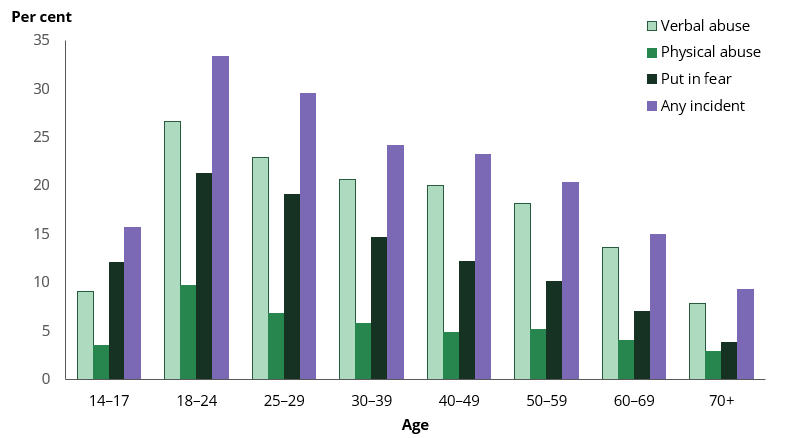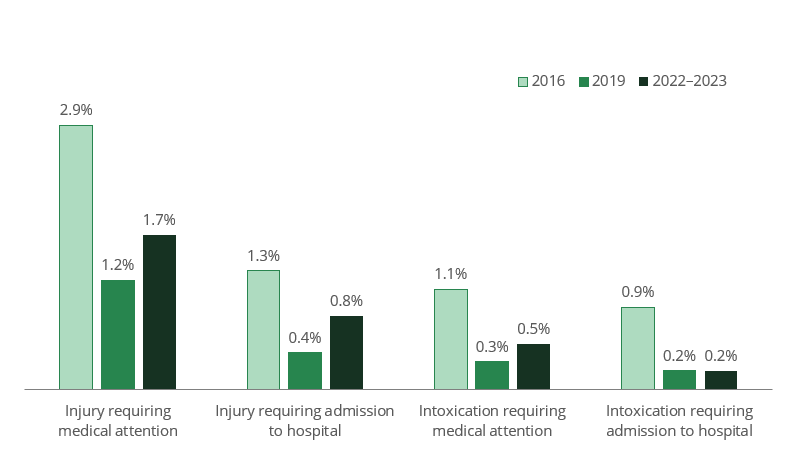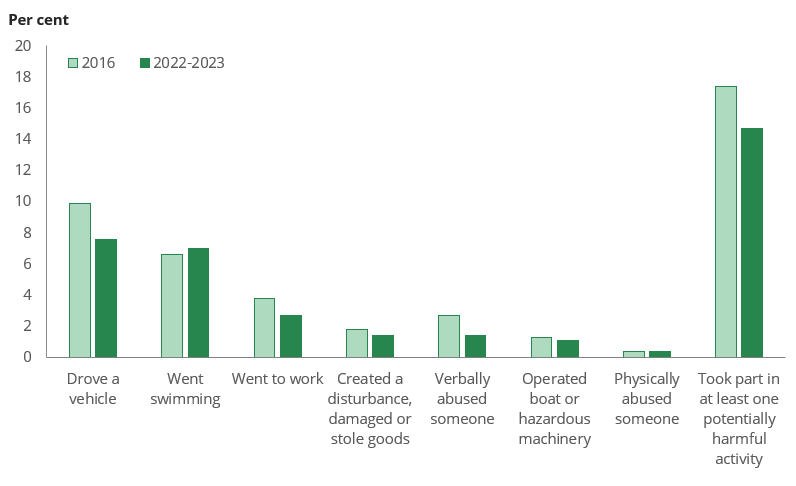Help is available. If you or someone close to you is in immediate danger, please call 000. For information, support and counselling, see Find support.
Family, domestic and sexual violence is a major health and welfare issue in Australia, occurring across all socioeconomic and demographic groups, but predominantly affecting women and children. These types of violence can have a serious impact on individuals, families and communities and can inflict physical injury, psychological trauma and emotional suffering. These effects can be long-lasting and can affect future generations.
The use of alcohol is responsible for 5.1% of the global burden of disease and has significant social and economic consequences. The use of alcohol can also result in harm to other people such as family members, friends, co-workers and strangers (WHO 2023).
Growing numbers of women experienced harms from people under the influence of alcohol
The 2022–2023 National Drug Strategy Household Survey (NDSHS) asked respondents whether, in the previous 12 months, someone under the influence of or affected by alcohol had:
- verbally abused them;
- physically abused them; or
- put them in fear.
Experiencing any of these behaviours is defined as having experiencing harm from someone under the influence of alcohol. Respondents could report experiencing multiple harms and could specify multiple people responsible for the harms (‘perpetrators’) if multiple incidents of harms had been experienced from different people in the previous 12 months.
As in 2019, about 1 in 5 people (21%) aged 14 and over in 2022–2023 were verbally abused, physically abused, or put in fear by someone under the influence of alcohol in the previous 12 months. This equates to 4.6 million Australians experiencing harm from someone under the influence of alcohol in the previous 12 months in 2022–2023.
Despite no substantial changes occurring between 2019 and 2022–2023 at the national level, there were rising rates of harms experienced by women from someone under the influence of alcohol, and falling rates experienced by men:
- Women were more likely to have experienced verbal abuse in 2022–2023 (17.6%) compared with 2019 (15.9%), while the rates for men fell from 19.6% to 17.6%.
- Similarly, the proportion of women who experienced physical abuse increased from 4.0% in 2019 to 5.3% in 2022–2023. For men it remained relatively stable and was 5.2% in 2022–2023.
- The proportion of women who were put in fear increased between 2019 (13.3%) and 2022–2023 (14.7%), and they were 1.6 times as likely as men (9.1% in 2022–2023) to have been put in fear in the previous 12 months. This is the highest disparity seen since the question was introduced in 2007.
Overall, 2.4 million women had experienced harm from someone under the influence of alcohol (an increase from 2.2 million in 2019), as had 2.2 million men (down from 2.3 million).
The proportion of people experiencing harm from someone under the influence of alcohol varied by age. Those aged 18–24 were the most likely to have experienced any harm from someone under the influence of alcohol in the previous 12 months (33%), followed by people aged 25–29 (30%) and 30–39 (24%). People in these three age groups were also the most likely to report having experienced each individual harm (Figure 1).

Source: NDSHS 2022–2023, Table 4.56.
Men and women experience alcohol-related harms from different people
In 2022–2023, both males and females who had experienced harm from someone under the influence of alcohol reported that these harms were most often perpetrated by a stranger, although these proportions varied and were much higher for males (Table 1).
For women, the next most common person under the influence of alcohol responsible for the harm was a current or former spouse or partner (reflecting a known association between alcohol use and family, domestic and sexual violence, AIHW 2023), while for men the next most likely perpetrator was some other person known to them.
Table 1: Relationship of perpetrators to the people aged 14 and over who experienced harms, by gender, 2022–2023 (per cent)Perpetrator | Verbal abuse Males | Verbal abuse Females | Physical abuse Males | Physical abuse Females | Put in fear Males | Put in fear Females |
|---|
Someone not known to me | 69.6 | 51.4 | 65.4 | 38.9 | 76.1 | 59.1 |
|---|
Current or ex-spouse or partner | 10.2 | 25.4 | 15 | 34.2 | 6.7 | 19.4 |
|---|
Other relative | 10.5 | 18.6 | 12.1 | 15.3 | 11.5 | 14.9 |
|---|
Friends | 10 | 7.3 | *8.3 | *7.8 | 7.5 | 8.7 |
|---|
Other person known to me | 18.5 | 17.8 | 19.3 | 16.9 | 15.6 | 16.4 |
|---|
* Estimate has a relative standard error of 25% to 50% and should be interpreted with caution.
Notes
1. Data are limited to people who experienced at least one harm from someone under the influence of alcohol in the previous 12 months.
2. Respondents could select more than one response.
Source: NDSHS 2022–2023, Table 4.61.
Overall, more people experienced harms from someone under the influence of alcohol in domestic settings in 2022–2023 than in 2019. Among all people who experienced physical abuse from someone under the influence of alcohol, the proportion who experienced it from a current or ex-spouse or other relative increased from 31% in 2019 to 38% in 2022–2023. Similar trends occurred for verbal abuse (from 30% in 2019 to 33% in 2022–2023) and being put in fear (from 24% to 28%).
More people were injured while affected by alcohol
In 2022–2023, more people than in 2019 reported being injured while under the influence of alcohol in the last 12 months (Figure 2).

Notes
1. Data are limited to people who consumed alcohol in the previous 12 months.
2. Respondents could select more than one response.
Source: NDSHS 2022–2023, Table 4.51.
Those who consumed alcohol at risky levels (more than 10 standard drinks a week or more than 4 standard drinks in a single day at least once a month) were 14 times as likely to experience an injury requiring medical attention (4.2% compared with *0.3%) as those who did not drink at risky levels, and were 10.5 times as likely to have experienced an injury requiring admission to hospital (2.1% compared with *0.2%).
* Estimate has a relative standard error between 25% and 50% and should be interpreted with caution.
Fewer people took part in risky activities while under the influence of alcohol
Respondents were asked about whether they had undertaken some activities, for example going to work, going swimming, or driving a motor vehicle, while under the influence of or affected by alcohol in the previous 12 months.
In 2022–2023, about 1 in 7 people (14.7%) took part in at least one potentially harmful activity while under the influence of alcohol (Figure 3). The most common activity was driving a vehicle (7.6%), followed by swimming (7.0%), and going to work (2.7%).

Note: Data are limited to people who consumed alcohol in the previous 12 months.
Source: NDSHS 2022–2023, Table 4.63.
The proportion of people who took part in at least one risky activity under the influence of alcohol reduced from 17.4% in 2016 to 14.7% in 2022–2023, continuing the downward trend occurring since 2010 when 22% of people had done so. Similar reductions occurred in individual risky activities, including driving a motor vehicle.
Who was more likely to have taken part in risky activities while under the influence of alcohol?
In 2022–2023, 1 in 4 people (25%) who consumed alcohol at risky levels had taken part in a least one risky activity under the influence of alcohol. Compared to those who drank alcohol in ways that reduced the health risks from drinking alcohol (NHMRC 2020), people who drank at risky levels were:
- 18 times as likely to have verbally abused someone;
- 8.3 times as likely to have created a disturbance, damaged or stolen goods;
- 5.4 times as likely to have gone swimming;
- 3.6 times as likely to have gone to work; and
- 2.9 times as likely to have driven a motor vehicle, while under the influence of alcohol.
Men who consumed alcohol were more likely than women who had done so to report engaging in risky activities. Men were more likely to have taken part in any risky activity (18.3% compared to 11.1%), to have driven a motor vehicle (10.5% compared to 4.7%) and to have operated a boat or other hazardous machinery (1.8% compared to *0.4%) while under the influence of alcohol.
* Estimate has a relative standard error between 25% and 50% and should be interpreted with caution.


